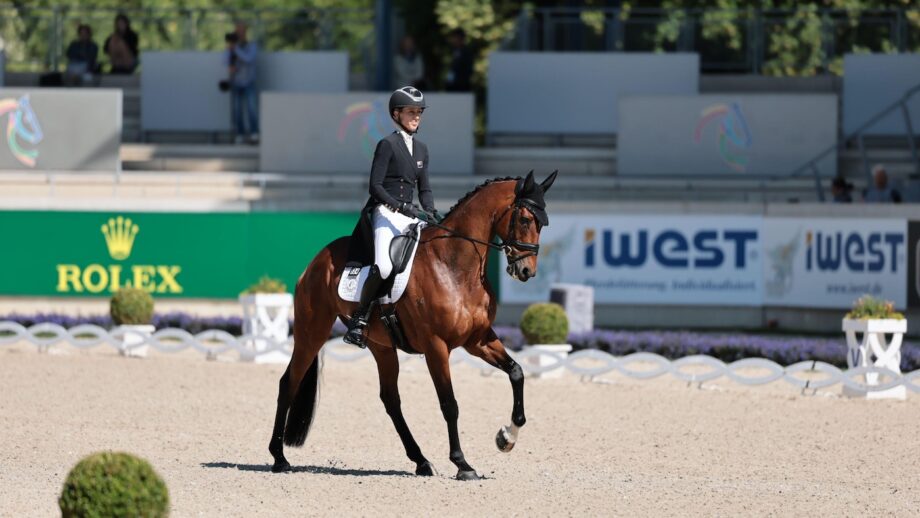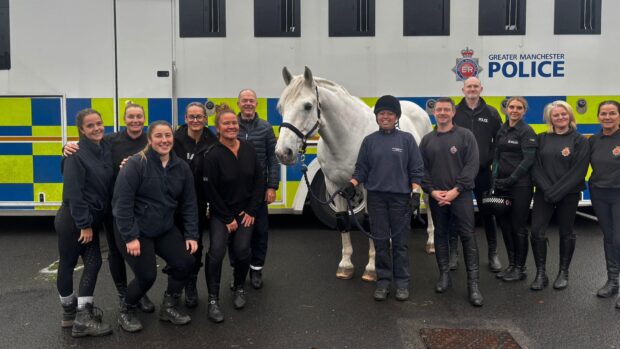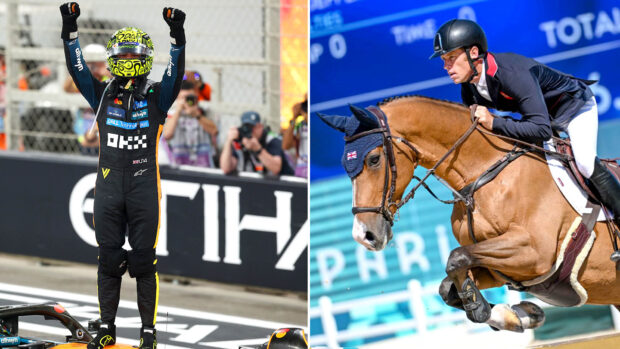Thoroughbreds – especially former racehorses – arrive in the dressage arena carrying baggage. Too hot. Too tense. Too flat. But Louise Robson specialises in dressage training for thoroughbreds and sees it differently.
Louise is founder of Thoroughbred Dressage and trainer of advanced-level ex-racers – including The late Queen’s homebred Quadrille who went from intro to inter II.
“Thoroughbreds have got the heart of a lion,” she says. “Their sensitivity is their superpower – if you ride it right.”
That sensitivity, approached with patience, becomes a fast-track to learning.
“They never want to make mistakes,” she says. “They learn fast – sometimes too fast – so you’ve got to keep their brain interested while their body catches up.”
Why thoroughbreds can excel in dressage
There’s plenty to like about training thoroughbreds for the dressage ring – especially their walk and canter.
“In racing, you don’t see trot or canter in the sales ring. You buy them off a walk,” Louise explains. “That’s why so many have natural swing and huge overtrack – and in tests, the walk is often double-marked.”
BDCC Level 3 coach and list 2 judge Alice Oppenheimer agrees: “If you can show relaxation as well, you’ll pick up serious marks.”
For FEI judge and trainer Isobel Wessels , it’s straightforward: “It’s not about what the horse is – it’s about what it learns to do. That’s what we should be marking.”
Work with the build
Thoroughbreds are often long through their body, croup-high and built to pull – that’s not a flaw, just a different starting point.
“They’re not wrong,” Louise says. “They’re built for something else. Our job is to show them a new way to use their bodies.”
Isobel agrees: “When you ask for go, they want to take the nose down and pull forward – because that’s how they win a race.
“So the horse learns to pull against the bit. They’re not so easy to collect because of that, but don’t try to squash the horse into what you think it should be. Start with what you’ve got and develop from there.
“You’re not just riding what the horse already does – you ride the solution to the problem.”
Dressage training for thoroughbreds
4 progressive exercises to try
{"content":"PHA+PHN0cm9uZz4xLiBUdXJuIHRoZSBzaG91bGRlcnMgKGxlZy15aWVsZCBhbmQgc3F1YXJlcyk8L3N0cm9uZz48L3A+CjxwPlRob3JvdWdoYnJlZHMgb2Z0ZW4gbW92ZSBhcyBvbmUgcGllY2UuIFRoZSBmaXJzdCBqb2I\/IFNlcGFyYXRlIGZyb250IGVuZCBmcm9tIGJhY2sgZW5kLjwvcD4KPHA+4oCcPGEgaHJlZj0iaHR0cHM6Ly93d3cuaG9yc2VhbmRob3VuZC5jby51ay5tYXN0ZXIucHVibGljLmtleXN0b25lLXByb2QtZWtzLWV1dzEuZnV0dXJlcGxjLmVuZ2luZWVyaW5nLm1hc3Rlci5wdWJsaWMua2V5c3RvbmUtcHJvZC1la3MtZXV3MS5mdXR1cmVwbGMuZW5naW5lZXJpbmcvZmVhdHVyZXMvaG93LXRvLXJpZGUtbGVnLXlpZWxkLXBlcmZlY3RseS01MzQxMzMiPkxlZy15aWVsZDwvYT4sIHNxdWFyZXMsIHNob3VsZGVyIHR1cm5zIOKAkyBhbGwgYnJpbGxpYW50LOKAnSBzYXlzIExvdWlzZS4g4oCcVGhleSB0ZWFjaCB0aGUgaG9yc2UgdG8gbW92ZSBpdHMgc2hvdWxkZXJzIGluZGVwZW5kZW50bHku4oCdPC9wPgo8cD5UcnkgdmlzdWFsaXNpbmcsIG9yIG1hcmtpbmcgb3V0IGEgc3F1YXJlLCBhbmQgdGhlbiBvbiBlYWNoIGNvcm5lciB0aGUgaG9yc2Ugc2hvdWxkIGJyaW5nIHRoZSBvdXRzaWRlIHNob3VsZGVyIGFyb3VuZCBmb3IgdGhlIHR1cm4uPC9wPgo8cD7igJxUaGVzZSBtb3ZlbWVudHMgaGVscCBleHBhbmQgdGhlaXIgY2hlc3QgYW5kIHRha2UgdGhlaXIgZnJvbnQgbGVncyBvdXQgaW4gZnJvbnQgb2YgdGhlbSzigJ0gTG91aXNlIGFkZHMuIOKAnExvbmctdGVybSB0aGF04oCZbGwgbGVhZCB0byB0aGUgbGlmdCBhbmQgcmVhY2ggd2XigJlyZSBsb29raW5nIGZvci7igJ08L3A+CjxwPjxzdHJvbmc+Mi4gU3BpcmFsLWluIHRvIGxlZy15aWVsZCBvdXQgKG9uIGEgY2lyY2xlKTwvc3Ryb25nPjwvcD4KPHA+VGhlIGdvYWwgd2l0aCB0aGlzIG9uZSBpcyB0byBlbmdhZ2UgdGhlIGluc2lkZSBoaW5kIGFuZCwgYWdhaW4sIGZyZWUgdGhlIHNob3VsZGVycy48L3A+CjxwPuKAnFRyYWNrIHN0cmFpZ2h0IG9uIHRoZSBjaXJjbGUsIGFuZCB5b3XigJlsbCBmZWVsIHRoZSBoaW5kbGVncyBjb21lIHVuZGVyIOKAkyB0aGUgY2lyY2xlIGRvZXMgaXQgZm9yIHlvdSzigJ0gSXNvYmVsIGV4cGxhaW5zLjwvcD4KPHA+RnJvbSBhIDIwbSBjaXJjbGUsIHNwaXJhbCBpbiB0byBhcm91bmQgMTAtMTJtLCB0aGVuIGxlZy15aWVsZCBiYWNrIG91dCB0byB0aGUgdHJhY2suIEtlZXAgYSBzbGlnaHQsIGNvbnNpc3RlbnQgaW5zaWRlIGJlbmQgYW5kIHRoZSB0ZW1wbyBzdGVhZHkg4oCTIGRvbuKAmXQgbGV0IHRoZSBob3JzZSBmYWxsIGluIG9yIHJ1c2ggb3V0LjwvcD4KPHA+PHN0cm9uZz4zLiBUcmFuc2l0aW9ucyBhbmQgZ2VhciBjaGFuZ2VzPC9zdHJvbmc+PC9wPgo8cD5Zb3XigJl2ZSBoZWFyZCBpdCBiZWZvcmUsIGJ1dCBldmVyeSB0cmFpbmVyIHdlIHNwb2tlIHRvIGVtcGhhc2lzZWQgaXQgYWdhaW46IHRyYW5zaXRpb25zLCB0cmFuc2l0aW9ucywgdHJhbnNpdGlvbnMuPC9wPgo8cD5Vc2Ugc2ltcGxlIHRyYW5zaXRpb24gbGFkZGVycyBsaWtlIHdhbGvigJN0cm904oCTd2Fsaywgd2Fsa+KAk2hhbHTigJN3YWxrIG9yIHRyb3TigJNoYWx04oCTdHJvdCBvbiBhIDIwbSBjaXJjbGUgdG8gYnVpbGQgYmFsYW5jZS4gTWl4IGluIHRyYW5zaXRpb25zIHdpdGhpbiB0aGUgcGFjZSwgdG9vIOKAkyBvbiBhIGNpcmNsZSwgYXNrIGZvciBzbGlnaHRseSBiaWdnZXIsIHRoZW4gc21hbGxlciBzdGVwcywgZm9jdXNpbmcgb24gc3RyaWRlIGxlbmd0aCB3aGlsZSBtYWludGFpbmluZyB0aGUgc2FtZSB0ZW1wby48L3A+CjxwPuKAnFBsYXkgd2l0aCB0aGUgc2l6ZSBvZiB0cm90IOKAkyBub3QgdGhlIHNwZWVkLOKAnSBzYXlzIElzb2JlbC48L3A+CjxwPjxzdHJvbmc+NC4gTWVkaXVtIGNhbnRlciB3aXRob3V0IGdhbGxvcGluZzwvc3Ryb25nPjwvcD4KPHA+UHJhY3Rpc2luZyB0aGlzIGluIGNhbnRlciwgZXNwZWNpYWxseSBvbiBhIGNpcmNsZSwgd2lsbCBwcmVwIHlvdXIgaG9yc2UgdG8gc2hvdyBhIHByb3BlciBtZWRpdW0gb3IgZXh0ZW5kZWQgY2FudGVyIGluIHRoZSB0ZXN0IOKAkyB3aXRob3V0IHJpc2tpbmcgYW4gYWNjaWRlbnRhbCBleGl0IGF0IEEuPC9wPgo8cD7igJxMZW5ndGhlbiB0aGUgc3RyaWRlLCBkb24mIzgyMTc7dCBjaGFuZ2UgdGhlIHJoeXRobSzigJ0gc2F5cyBBbGljZS4g4oCcV2Ugd2FudCBhIHRocmVlLWJlYXQgY2FudGVyIOKAkyBub3QgYSBmb3VyLXRpbWUgZ2FsbG9wLuKAnTwvcD4KPGgyPlRvcCB0aXBzIGZvciBpbXByb3ZpbmcgeW91ciB0aG9yb3VnaGJyZWTigJlzIHdheSBvZiBnb2luZzwvaDI+CjxoMz5CdWlsZCBzdHJlbmd0aDwvaDM+CjxwPjxhIGhyZWY9Imh0dHBzOi8vd3d3LmhvcnNlYW5kaG91bmQuY28udWsubWFzdGVyLnB1YmxpYy5rZXlzdG9uZS1wcm9kLWVrcy1ldXcxLmZ1dHVyZXBsYy5lbmdpbmVlcmluZy5tYXN0ZXIucHVibGljLmtleXN0b25lLXByb2QtZWtzLWV1dzEuZnV0dXJlcGxjLmVuZ2luZWVyaW5nL2ZlYXR1cmVzL2JlbmVmaXRzLW9mLWxvbmctcmVpbmluZy03MzU0MDMiPkxvbmctcmVpbmluZzwvYT4sIDxhIGhyZWY9Imh0dHBzOi8vd3d3LmhvcnNlYW5kaG91bmQuY28udWsubWFzdGVyLnB1YmxpYy5rZXlzdG9uZS1wcm9kLWVrcy1ldXcxLmZ1dHVyZXBsYy5lbmdpbmVlcmluZy5tYXN0ZXIucHVibGljLmtleXN0b25lLXByb2QtZWtzLWV1dzEuZnV0dXJlcGxjLmVuZ2luZWVyaW5nL2ZlYXR1cmVzL2hvcnNlLWNvcmUtcG9sZXdvcmstZXhlcmNpc2VzLTY0MzA5MiI+cmFpc2VkIHBvbGVzPC9hPiwgYW5kIDxhIGhyZWY9Imh0dHBzOi8vd3d3LmhvcnNlYW5kaG91bmQuY28udWsubWFzdGVyLnB1YmxpYy5rZXlzdG9uZS1wcm9kLWVrcy1ldXcxLmZ1dHVyZXBsYy5lbmdpbmVlcmluZy5tYXN0ZXIucHVibGljLmtleXN0b25lLXByb2QtZWtzLWV1dzEuZnV0dXJlcGxjLmVuZ2luZWVyaW5nL2ZlYXR1cmVzL3RoZS1iZW5lZml0cy1vZi1oaWxsd29yay1mb3ItaG9yc2VzLWhoLXBsdXMtNzA5NjUwIj5oaWxsIHdvcms8L2E+IGhlbHAgYnVpbGQgdGhlIHJpZ2h0IGtpbmQgb2YgbXVzY2xlLjwvcD4KPGRpdiBpZD0iYXR0YWNobWVudF85MDA5NzEiIHN0eWxlPSJ3aWR0aDogMTQxMHB4IiBjbGFzcz0id3AtY2FwdGlvbiBhbGlnbm5vbmUiPjxpbWcgZmV0Y2hwcmlvcml0eT0iaGlnaCIgZGVjb2Rpbmc9ImFzeW5jIiBhcmlhLWRlc2NyaWJlZGJ5PSJjYXB0aW9uLWF0dGFjaG1lbnQtOTAwOTcxIiBjbGFzcz0ibGF6eWxvYWQgYmx1ci11cCBzaXplLWZ1bGwgd3AtaW1hZ2UtOTAwOTcxIiBkYXRhLXByb2Nlc3NlZCBzcmM9Imh0dHBzOi8va2V5YXNzZXRzLnRpbWVpbmN1ay5uZXQvaW5zcGlyZXdwL2xpdmUvd3AtY29udGVudC91cGxvYWRzL3NpdGVzLzE0LzIwMTcvMDMvbmV3LWhoLXBsYWNlaG9sZGVyLTIwMHgyMDAucG5nIiBkYXRhLXNyYz0iaHR0cHM6Ly9rZXlhc3NldHMudGltZWluY3VrLm5ldC9pbnNwaXJld3AvbGl2ZS93cC1jb250ZW50L3VwbG9hZHMvc2l0ZXMvMTQvMjAyNS8wOC9EU0M2NDM5XzMzMTEyNTE1Ml81MjAzNTcwMDEuanBnIiBhbHQ9IkxvbmcgcmVpbmluZyB0aG9yb3VnaGJyZWQgb3ZlciBwb2xlcyIgd2lkdGg9IjE0MDAiIGhlaWdodD0iNzg4IiBkYXRhLXNpemVzPSJhdXRvIiBkYXRhLXNyY3NldD0iaHR0cHM6Ly9rZXlhc3NldHMudGltZWluY3VrLm5ldC9pbnNwaXJld3AvbGl2ZS93cC1jb250ZW50L3VwbG9hZHMvc2l0ZXMvMTQvMjAyNS8wOC9EU0M2NDM5XzMzMTEyNTE1Ml81MjAzNTcwMDEuanBnIDE0MDB3LCBodHRwczovL2tleWFzc2V0cy50aW1laW5jdWsubmV0L2luc3BpcmV3cC9saXZlL3dwLWNvbnRlbnQvdXBsb2Fkcy9zaXRlcy8xNC8yMDI1LzA4L0RTQzY0MzlfMzMxMTI1MTUyXzUyMDM1NzAwMS0zMDB4MTY5LmpwZyAzMDB3LCBodHRwczovL2tleWFzc2V0cy50aW1laW5jdWsubmV0L2luc3BpcmV3cC9saXZlL3dwLWNvbnRlbnQvdXBsb2Fkcy9zaXRlcy8xNC8yMDI1LzA4L0RTQzY0MzlfMzMxMTI1MTUyXzUyMDM1NzAwMS02MzB4MzU1LmpwZyA2MzB3LCBodHRwczovL2tleWFzc2V0cy50aW1laW5jdWsubmV0L2luc3BpcmV3cC9saXZlL3dwLWNvbnRlbnQvdXBsb2Fkcy9zaXRlcy8xNC8yMDI1LzA4L0RTQzY0MzlfMzMxMTI1MTUyXzUyMDM1NzAwMS0xMzV4NzYuanBnIDEzNXcsIGh0dHBzOi8va2V5YXNzZXRzLnRpbWVpbmN1ay5uZXQvaW5zcGlyZXdwL2xpdmUvd3AtY29udGVudC91cGxvYWRzL3NpdGVzLzE0LzIwMjUvMDgvRFNDNjQzOV8zMzExMjUxNTJfNTIwMzU3MDAxLTMyMHgxODAuanBnIDMyMHcsIGh0dHBzOi8va2V5YXNzZXRzLnRpbWVpbmN1ay5uZXQvaW5zcGlyZXdwL2xpdmUvd3AtY29udGVudC91cGxvYWRzL3NpdGVzLzE0LzIwMjUvMDgvRFNDNjQzOV8zMzExMjUxNTJfNTIwMzU3MDAxLTYyMHgzNDkuanBnIDYyMHcsIGh0dHBzOi8va2V5YXNzZXRzLnRpbWVpbmN1ay5uZXQvaW5zcGlyZXdwL2xpdmUvd3AtY29udGVudC91cGxvYWRzL3NpdGVzLzE0LzIwMjUvMDgvRFNDNjQzOV8zMzExMjUxNTJfNTIwMzU3MDAxLTkyMHg1MTguanBnIDkyMHcsIGh0dHBzOi8va2V5YXNzZXRzLnRpbWVpbmN1ay5uZXQvaW5zcGlyZXdwL2xpdmUvd3AtY29udGVudC91cGxvYWRzL3NpdGVzLzE0LzIwMjUvMDgvRFNDNjQzOV8zMzExMjUxNTJfNTIwMzU3MDAxLTEyMjB4Njg3LmpwZyAxMjIwdyIgc2l6ZXM9IihtYXgtd2lkdGg6IDE0MDBweCkgMTAwdncsIDE0MDBweCIgLz48cCBpZD0iY2FwdGlvbi1hdHRhY2htZW50LTkwMDk3MSIgY2xhc3M9IndwLWNhcHRpb24tdGV4dCI+UmFjZWhvcnNlIHJldHJhaW5lciBEYXJyZWxsIFNjYWlmZSBsb25nLXJlaW5zIGEgdGhvcm91Z2hicmVkIG92ZXIgcG9sZXMg4oCTIGEgZ3JlYXQgZXhlcmNpc2UgZm9yIGJ1aWxkaW5nIHN0cmVuZ3RoIGFuZCBlbmNvdXJhZ2luZyBzd2luZy4gQ3JlZGl0OiBMdWN5IE1lcnJlbGw8L3A+PC9kaXY+CjxwPuKAnEnigJltIGEgYmlnIGFkdm9jYXRlIGZvciBsb25nLXJlaW5pbmcsIGFuZCBzcGVuZGluZyBhcyBtdWNoIHRpbWUgd29ya2luZyBvZmYgaG9yc2UgYXMgb24gaG9yc2Us4oCdIExvdWlzZSBzYXlzLjwvcD4KPHA+4oCcVGhvcm91Z2hicmVk4oCZcyBiYWNrcyBhcmVu4oCZdCBidWlsdCB0byBjYXJyeSB1cyDigJMgbm90IHRoYXQgdGhleSBjYW7igJl0LCBidXQgdGhlaXIgYmFja3MgZHJvcCBkb3duIG5hdHVyYWxseSBhd2F5IGZyb20gdXMgc28gdGhleeKAmXZlIGdvdCB0byBiZSBzdHJvbmdlciB0byBrZWVwIGVuZ2FnZWQgYW5kIGxpZnQgdXAgdG8gdXMg4oCTIGFuZCB0aGF0IHRha2VzIGEgbG9uZyB0aW1lLuKAnTwvcD4KPHA+PGEgaHJlZj0iaHR0cHM6Ly93d3cuaG9yc2VhbmRob3VuZC5jby51ay5tYXN0ZXIucHVibGljLmtleXN0b25lLXByb2QtZWtzLWV1dzEuZnV0dXJlcGxjLmVuZ2luZWVyaW5nLm1hc3Rlci5wdWJsaWMua2V5c3RvbmUtcHJvZC1la3MtZXV3MS5mdXR1cmVwbGMuZW5naW5lZXJpbmcvdGFnL3BvbGV3b3JrLWV4ZXJjaXNlcyI+UG9sZXdvcmsgZXhlcmNpc2VzPC9hPiBhbHNvIGVuY291cmFnZSBzd2luZyBhbmQgYSB0cnVlIGNvbm5lY3Rpb24uPC9wPgo8cD7igJxJZiB0aGUgYmFjayBpcyBzdXBwbGUsIHRoZSBlbmVyZ3kgY2FuIHBhc3MgdGhyb3VnaCB0aGUgbmVjayB0byB0aGUgYnJpZGxlIGFuZCBiYWNrIHRvIHRoZSByaWRlciDigJMgaXTigJlzIGxpa2UgYSBiaWcgcnViYmVyIGJhbmQs4oCdIHNheXMgSXNvYmVsLjwvcD4KPHA+VHJ5IGZhbi1zaGFwZWQgcG9sZXMgaW4gYSBjb3JuZXIg4oCTIHRoZSB0aWdodGVyIHRoZSBhcmMsIHRoZSBtb3JlIGxpZnQgYW5kIHJvdW5kbmVzcyB5b3UgY3JlYXRlLjwvcD4KPGgzPlJpbmdjcmFmdCBhbmQgbWFuYWdpbmcgd2FybS11cHM8L2gzPgo8cD5Db21wZXRpdGlvbiBkYXkgY2FuIGJlIGEgc2Vuc29yeSBvdmVybG9hZCBmb3IgZm9ybWVyIHJhY2VycyBpbiBwYXJ0aWN1bGFyLCBzbyBrbm93aW5nIDxhIGhyZWY9Imh0dHBzOi8vd3d3LmhvcnNlYW5kaG91bmQuY28udWsubWFzdGVyLnB1YmxpYy5rZXlzdG9uZS1wcm9kLWVrcy1ldXcxLmZ1dHVyZXBsYy5lbmdpbmVlcmluZy5tYXN0ZXIucHVibGljLmtleXN0b25lLXByb2QtZWtzLWV1dzEuZnV0dXJlcGxjLmVuZ2luZWVyaW5nL2hvcnNlLWNhcmUvaG93LXRvLW1hbmFnZS1leC1yYWNlaG9yc2VzLTkwNzY0NSI+aG93IHRvIG1hbmFnZSB5b3VyIGV4LXJhY2Vob3JzZTwvYT4gaXMga2V5LjwvcD4KPHA+4oCcWW91IGNhbuKAmXQgc2l0IHRoZW0gZG93biBhbmQgZXhwbGFpbiB0aGV54oCZdmUgZmluaXNoZWQgcmFjaW5nLOKAnSBzYXlzIExvdWlzZS4g4oCcWW91IG9mdGVuIHdvbuKAmXQga25vdyB0aGVpciB0cmlnZ2VycyB1bnRpbCB5b3UgaGl0IHRoZW0g4oCTIGFuZCB3aGVuIHRoaW5ncyBnbyBzaWRld2F5cywgaXTigJlzIG5vdCB0aGVpciBmYXVsdC4gSXTigJlzIGp1c3QgcGFydCBvZiB0aGUgbGVhcm5pbmcgcHJvY2Vzcy7igJ08L3A+CjxwPlRvIGhlbHAgdGhlbSBjb3BlLCBMb3Vpc2UgcmVjb21tZW5kcyBtaW1pY2tpbmcgdGhlIHN0cnVjdHVyZSB0aGV54oCZcmUgZmFtaWxpYXIgd2l0aC4gRm9yIGV4YW1wbGU6PC9wPgo8dWw+CjxsaT5XYWxraW5nIHRoZSBob3JzZSBpbiBoYW5kIG9uIGFycml2YWw8L2xpPgo8bGk+QnJpbmdpbmcgYSBmYW1pbGlhciB2b2ljZSB0byBjYWxsIHRoZSB0ZXN0PC9saT4KPGxpPkhhdmluZyBzb21lb25lIGxlYWQgdGhlbSBmcm9tIHdhcm0tdXAgdG8gdGhlIGFyZW5hPC9saT4KPC91bD4KPHA+QXMgTG91aXNlIHB1dHMgaXQsIHRoZXnigJlyZSB1c2VkIHRvIGdvaW5nIGV2ZXJ5d2hlcmUgaW4gYSBzdHJpbmcsIG5vdCBsZWF2aW5nIHRoZSBncm91cCBhbmQgd29ya2luZyBhbG9uZS4gQWJvdmUgYWxsLCBnbyBhdCB0aGUgaG9yc2XigJlzIHBhY2U6IOKAnEl04oCZcyBhIHByb2Nlc3MsIG5vdCBhbiBvdmVybmlnaHQgZml4LuKAnTwvcD4KPGRpdiBpZD0iYXR0YWNobWVudF85MDA5NTgiIHN0eWxlPSJ3aWR0aDogMTQxMHB4IiBjbGFzcz0id3AtY2FwdGlvbiBhbGlnbm5vbmUiPjxpbWcgZGVjb2Rpbmc9ImFzeW5jIiBhcmlhLWRlc2NyaWJlZGJ5PSJjYXB0aW9uLWF0dGFjaG1lbnQtOTAwOTU4IiBjbGFzcz0ibGF6eWxvYWQgYmx1ci11cCBzaXplLWZ1bGwgd3AtaW1hZ2UtOTAwOTU4IiBkYXRhLXByb2Nlc3NlZCBzcmM9Imh0dHBzOi8va2V5YXNzZXRzLnRpbWVpbmN1ay5uZXQvaW5zcGlyZXdwL2xpdmUvd3AtY29udGVudC91cGxvYWRzL3NpdGVzLzE0LzIwMTcvMDMvbmV3LWhoLXBsYWNlaG9sZGVyLTIwMHgyMDAucG5nIiBkYXRhLXNyYz0iaHR0cHM6Ly9rZXlhc3NldHMudGltZWluY3VrLm5ldC9pbnNwaXJld3AvbGl2ZS93cC1jb250ZW50L3VwbG9hZHMvc2l0ZXMvMTQvMjAyNS8wOC9DVEhSTjUuanBnIiBhbHQ9IlJhY2Vob3JzZSBzdHJpbmciIHdpZHRoPSIxNDAwIiBoZWlnaHQ9Ijc4OCIgZGF0YS1zaXplcz0iYXV0byIgZGF0YS1zcmNzZXQ9Imh0dHBzOi8va2V5YXNzZXRzLnRpbWVpbmN1ay5uZXQvaW5zcGlyZXdwL2xpdmUvd3AtY29udGVudC91cGxvYWRzL3NpdGVzLzE0LzIwMjUvMDgvQ1RIUk41LmpwZyAxNDAwdywgaHR0cHM6Ly9rZXlhc3NldHMudGltZWluY3VrLm5ldC9pbnNwaXJld3AvbGl2ZS93cC1jb250ZW50L3VwbG9hZHMvc2l0ZXMvMTQvMjAyNS8wOC9DVEhSTjUtMzAweDE2OS5qcGcgMzAwdywgaHR0cHM6Ly9rZXlhc3NldHMudGltZWluY3VrLm5ldC9pbnNwaXJld3AvbGl2ZS93cC1jb250ZW50L3VwbG9hZHMvc2l0ZXMvMTQvMjAyNS8wOC9DVEhSTjUtNjMweDM1NS5qcGcgNjMwdywgaHR0cHM6Ly9rZXlhc3NldHMudGltZWluY3VrLm5ldC9pbnNwaXJld3AvbGl2ZS93cC1jb250ZW50L3VwbG9hZHMvc2l0ZXMvMTQvMjAyNS8wOC9DVEhSTjUtMTM1eDc2LmpwZyAxMzV3LCBodHRwczovL2tleWFzc2V0cy50aW1laW5jdWsubmV0L2luc3BpcmV3cC9saXZlL3dwLWNvbnRlbnQvdXBsb2Fkcy9zaXRlcy8xNC8yMDI1LzA4L0NUSFJONS0zMjB4MTgwLmpwZyAzMjB3LCBodHRwczovL2tleWFzc2V0cy50aW1laW5jdWsubmV0L2luc3BpcmV3cC9saXZlL3dwLWNvbnRlbnQvdXBsb2Fkcy9zaXRlcy8xNC8yMDI1LzA4L0NUSFJONS02MjB4MzQ5LmpwZyA2MjB3LCBodHRwczovL2tleWFzc2V0cy50aW1laW5jdWsubmV0L2luc3BpcmV3cC9saXZlL3dwLWNvbnRlbnQvdXBsb2Fkcy9zaXRlcy8xNC8yMDI1LzA4L0NUSFJONS05MjB4NTE4LmpwZyA5MjB3LCBodHRwczovL2tleWFzc2V0cy50aW1laW5jdWsubmV0L2luc3BpcmV3cC9saXZlL3dwLWNvbnRlbnQvdXBsb2Fkcy9zaXRlcy8xNC8yMDI1LzA4L0NUSFJONS0xMjIweDY4Ny5qcGcgMTIyMHciIHNpemVzPSIobWF4LXdpZHRoOiAxNDAwcHgpIDEwMHZ3LCAxNDAwcHgiIC8+PHAgaWQ9ImNhcHRpb24tYXR0YWNobWVudC05MDA5NTgiIGNsYXNzPSJ3cC1jYXB0aW9uLXRleHQiPlJhY2Vob3JzZXMgYXJlIHVzZWQgdG8gZ29pbmcgZXZlcnl3aGVyZSBpbiBhIHN0cmluZyDigJMgZHJlc3NhZ2UgZXhlcnRzIHZlcnkgZGlmZmVyZW50IGRlbWFuZHMgaW4gdGVybXMgb2YgdHJhaW5pbmcgYW5kIGNvbXBldGl0aW9uIGVudmlyb25tZW50cy4gQ3JlZGl0OiBBbGFteTwvcD48L2Rpdj4KPHA+Qm90aCBMb3Vpc2UgYW5kIEFsaWNlIGFkZCB0aGF0IHVzaW5nIGZyZWVzdHlsZSB0ZXN0cyBjYW4gYmUgaW5jcmVkaWJseSBoZWxwZnVsIOKAkyBlc3BlY2lhbGx5IGZvciBob3JzZXMgdGhhdCBnZXQgdGVuc2UgaW4gc2V0IHRlc3RzLiBZb3UgcmVtb3ZlIHRoZSByaWdpZCDigJxkbyBpdCBub3figJ0gc3RydWN0dXJlIGFuZCBpbnN0ZWFkIGdldCB0byByaWRlIHBhdHRlcm5zIHRoYXQgc3VpdCB5b3VyIGhvcnNlIGFuZCBob3cgeW91IHRyYWluIGF0IGhvbWUuPC9wPgo8cD5JZiB5b3VyIGhvcnNlIHNldHRsZXMgYmV0dGVyIGJ5IGNhbnRlcmluZyBiZWZvcmUgdHJvdHRpbmcsIHlvdSBjYW4gZG8gdGhhdC4gSWYgeW91IGtub3cgdGhleSBuZWVkIGEgPGEgaHJlZj0iaHR0cHM6Ly93d3cuaG9yc2VhbmRob3VuZC5jby51ay5tYXN0ZXIucHVibGljLmtleXN0b25lLXByb2QtZWtzLWV1dzEuZnV0dXJlcGxjLmVuZ2luZWVyaW5nLm1hc3Rlci5wdWJsaWMua2V5c3RvbmUtcHJvZC1la3MtZXV3MS5mdXR1cmVwbGMuZW5naW5lZXJpbmcvdmlkZW9zL2hvcnNlLXRyYWluaW5nLXZpZGVvcy9ob3ctdG8tcmlkZS1hLTEwbS1jaXJjbGUtdmlkZW8iPjEwbSBjaXJjbGU8L2E+IHRvIHNldCB1cCBmb3IgYSBiZXR0ZXIgbWVkaXVtIHRyb3QsIHlvdSBjYW4gYnVpbGQgaXQgaW4uPC9wPgo8cD5GcmVlc3R5bGUgYWxsb3dzIHlvdSB0byByaWRlIHRoZSBob3JzZSBpbiB0aGVpciBiZXN0IGJhbGFuY2Ug4oCTIHVzaW5nIGZhbWlsaWFyIHJvdXRpbmVzIHRoYXQgY3JlYXRlIGNvbWZvcnQgYW5kIHJlZHVjZSB0ZW5zaW9uLjwvcD4KPGgzPk1pbmRzZXQ6IG5vIHNob3J0Y3V0czwvaDM+CjxwPlRoZXJl4oCZcyBubyBmYXN0IHRyYWNrIGluIGRyZXNzYWdlIHRyYWluaW5nIGZvciB0aG9yb3VnaGJyZWRzIOKAkyBidXQgdGhlIHJlc3VsdHMgYXJlIHdvcnRoIGl0LjwvcD4KPGRpdiBjbGFzcz0iaW5qZWN0aW9uIj48L2Rpdj4KPHA+4oCcSXTigJlzIGxpa2UgZ2V0dGluZyBhIHNpeC1wYWNrLOKAnSBzYXlzIExvdWlzZS4g4oCcWW91IGRvbuKAmXQgZG8gMzAgZGF5cyBvZiBzaXQtdXBzIGFuZCBjYWxsIGl0IGRvbmUuIEl04oCZcyBzbG93LCBpdOKAmXMgbGF5ZXJlZCwgYW5kIGl0IHBheXMgb2ZmLjwvcD4KPHA+4oCcSWYgeW91IHNjaG9vbCB0d2ljZSBhIHdlZWssIHRoYXTigJlzIDEwMCBzZXNzaW9ucyBhIHllYXIuIFlvdeKAmXZlIGdvdCB0byBsb3ZlIHRoZSBwcm9jZXNzIOKAkyBhbmQgYmUgcHJvdWQgb2YgaXQu4oCdPC9wPgo8cD4K"}
Did you find this article helpful? You may also enjoy reading…
Buck Davidson and retrained racehorse Sorocaima finish fourth at Maryland 5 Star in 2024.
Credit: Amy Dragoo
You don't need a flashy warmblood to compete in affiliated dressage – all types and breeds of horse and pony are welcome.
Credit: Jon Stroud Media
Louise Robson and Quadrille, the second racehorse Louise retrained for The Queen
Credit: Thoroughbred Dressage/Louise Robson
Stay in touch with all the news in the run-up to and throughout the major shows and events during 2025 and beyond with a Horse & Hound subscription. Subscribe today for all you need to know ahead of these major events, plus online reports on the action as it happens from our expert team of reporters and in-depth analysis in our special commemorative magazines. Have a subscription already? Set up your unlimited website access now
H&H dressage and sport horse editor
Oscar graduated from York St John University with a master’s degree in Literature in 2021 and joined Horse & Hound in October 2023. Oscar worked for top dressage rider Emile Faurie for four years after finishing an equine management course at college. Under Emile’s tutelage, Oscar competed at the 2015 National Dressage Championships and travelled with Emile’s horses to CDIs at Aachen, Vidauban, Saumur and Achlieiten. Oscar continues to compete in dressage, alongside his day job.











